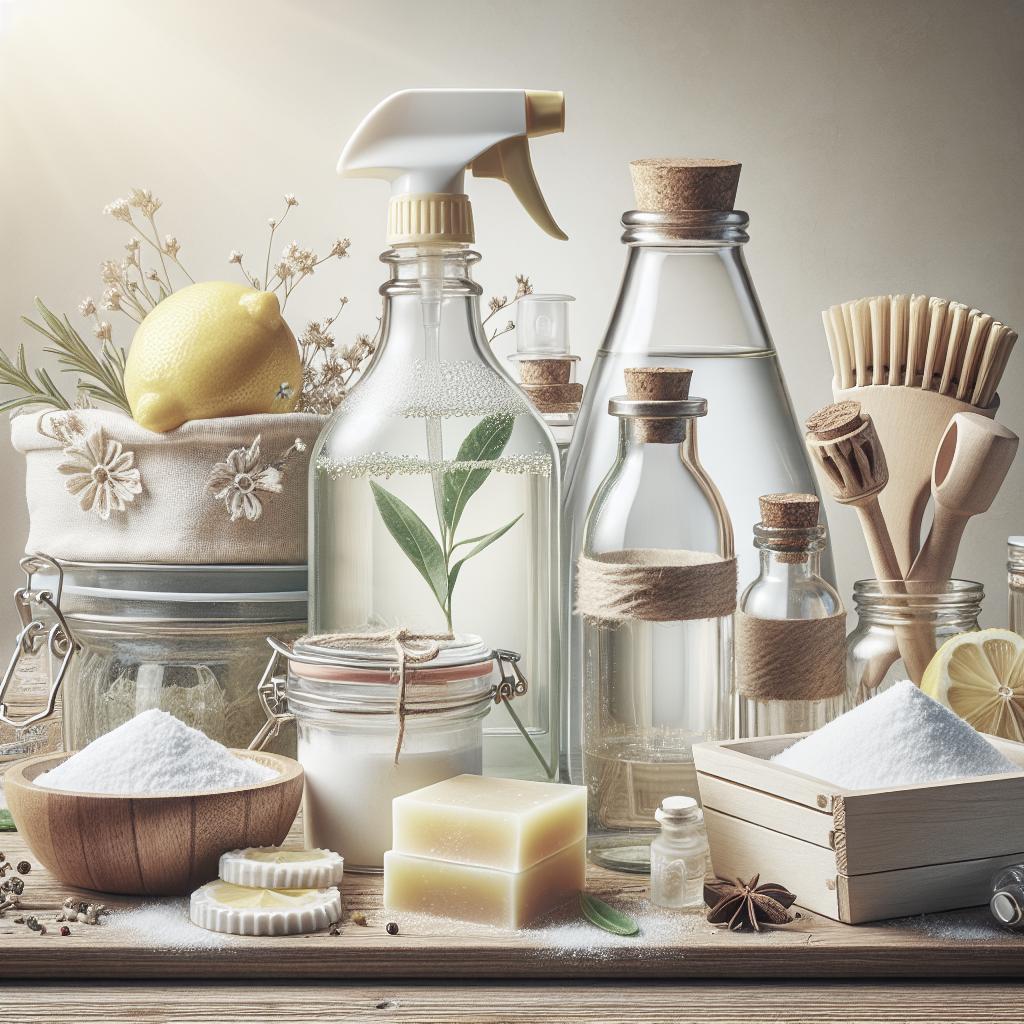DIY Eco Cleaning Products
In recent years, there has been a growing movement towards creating eco-friendly solutions for everyday needs, particularly in cleaning. This blog post explores the benefits and methods of making your own cleaning products at home. From cost efficiency to environmental benefits, crafting homemade cleaners using accessible ingredients can revolutionize your routine. Here, we dive into why DIY eco cleaning products are worth the effort, delve into essential ingredients and supplies, discuss safety tips, and offer a plethora of effective cleaning recipes for different household needs. Let’s embark on a journey towards a cleaner, greener lifestyle.
Why do it?
They’re health and eco-friendly
Conventional cleaning products often contain chemicals that can be harmful to both our health and the environment. Many store-bought cleaners include dangerous toxins and allergens that can exacerbate respiratory issues and other health conditions. By making your own cleaning products, you can control what goes into them, minimizing exposure to harmful substances.
Beyond their impact on our personal health, traditional cleaning solutions can be damaging to the environment. The packaging, manufacturing process, and eventual disposal of these products can contribute to pollution. Eco-friendly DIY cleaning products often use natural ingredients that break down more easily without releasing harmful toxins, making them a sustainable choice.
They’ll help you save money
Buying commercial cleaning products regularly can become quite expensive. Many of these products come with names that boast effectiveness at a high price. Making your own cleaning solutions at home can substantially cut down on costs, utilizing common household items like vinegar, baking soda, and essential oils.
Not only does creating your own cleaning products reduce immediate expenses, but it also minimizes shopping frequency. With a stock of versatile ingredients, you can whip up customized cleaners without last-minute trips to the store, saving time and gas money.
They’re just as effective as commercial cleaners
There’s a common misconception that homemade cleaning products aren’t as effective as their commercial counterparts. However, with the right ingredients and combinations, DIY solutions can tackle dirt and grime just as efficiently.
Many natural ingredients have antibacterial, antifungal, or other cleansing properties that make them perfect for various cleaning applications. From lemon’s cutting grease to vinegar’s disinfecting power, these natural solutions are tried and tested, often rivaling or surpassing the capabilities of store-bought products.
Supplies and ingredients you’ll need
Essentials
To start your journey into DIY eco cleaning, you’ll need a few basic ingredients. White vinegar, baking soda, castile soap, and lemon juice form the backbone of many homemade recipes because of their versatile cleaning properties. Distilled water is also essential as a base for many solutions.
You’ll also need tools such as spray bottles, measuring cups, and mixing bowls to prepare and store your concoctions. Labels will help keep your DIY arsenal organized and ensure you use the right cleaner for the right task.
Nice to have
Expanding beyond the essentials, there are additional ingredients and tools that enhance your DIY cleaning experience. Essential oils, such as tea tree, lavender, or eucalyptus, not only add a pleasant scent but also extra antibacterial properties.
Borax, washing soda, and citric acid are favorable for more robust cleaning needs. As your repertoire grows, consider acquiring reusable cleaning cloths, a dedicated cleaning bucket, and storage jars to further streamline your eco-friendly cleaning routine.
Essential cleaning safety tips
While DIY cleaning products are generally safer, it’s still important to follow safety guidelines to protect yourself and your home. Always test a small area for new cleaning mixtures, since different surfaces may react unexpectedly.
Properly label all homemade products, specifying the contents and any important usage details. This reduces the risk of accidents and ensures that the cleaners are used as intended. Additionally, store your cleaning solutions in a cool, dry place, away from children and pets.
DIY household cleaner recipes
1. All-purpose cleaner
Combine equal parts distilled water and white vinegar in a spray bottle. Add a few drops of tea tree essential oil for additional antibacterial properties. Use for general cleaning purposes on surfaces like countertops and windows.
This simple mix is effective for everyday cleaning and deodorizing. The acid of the vinegar cuts through grease and grime, while tea tree oil adds a fresh scent and extra cleaning power.
2. Vinegar-free all-purpose cleaner
Mix 2 cups of water with a tablespoon of castile soap in a spray bottle. Add 15 drops of lavender essential oil for fragrance. This recipe is perfect for those who dislike the smell of vinegar.
The gentle nature of castile soap makes it ideal for a variety of surfaces, leaving them clean without a strong aroma. Lavender essential oil is known for its calming properties, making this a serene cleaning experience.
3. Machine-safe laundry detergent
For a simple, eco-friendly laundry detergent, combine 1 cup of washing soda, 1 cup of baking soda, and 1 cup of grated castile soap in a jar. Use 2 tablespoons per load to clean your clothes naturally.
Unlike many commercial detergents, this mix is free of harsh chemicals, making it safe for sensitive skin. The combination effectively breaks down stains while maintaining fabric integrity.
4. Laundry detergent for delicates
Combine 1/4 cup of liquid castile soap with 1 tablespoon of baking soda and 10 drops of eucalyptus essential oil. Use sparingly on delicate fabrics, ensuring they stay fresh without damage.
This mixture provides gentle yet effective cleaning, preserving delicate fibers. Eucalyptus essential oil helps eliminate musty odors that delicate fabrics can retain.
5. Kitchen cleaner
Mix 1 cup of warm water, 1 cup of white vinegar, and a few drops of lemon essential oil in a spray bottle. Use on cutting boards and kitchen counters to sanitize and freshen.
Lemon oil provides a zesty scent while aiding in cutting through kitchen grease. Vinegar’s acetic acid tackles bacteria, making it ideal for food preparation areas.
6. Dish detergent
Combine 1/2 cup of castile soap with 1 tablespoon of washing soda. Add 20 drops of citrus essential oil for fragrance. Dilute with water as needed for a gentle yet effective solution.
This formula is tough on grease but gentle on your hands. The citrus oil adds a refreshing scent, making dishwashing more pleasant.
7. Grease cleaner
For tough kitchen grease, sprinkle baking soda on the affected area and spray with vinegar until it fizzles. Wipe clean after a few minutes with a cloth.
This reaction lifts grease and grime effectively, making it an eco-friendly alternative to harsh degreasers with minimal effort.
8. Bathroom cleaner
Mix 1 cup of baking soda and 1/4 cup of liquid castile soap with 1/2 cup of water. Add 20 drops of tea tree oil to combat mold and mildew.
This thick bathroom cleaner effectively tackles soap scum and bathroom odors, promoting a clean and breathable space.
9. Sanitizer
Combine 1/4 cup of isopropyl alcohol with 1 cup of vinegar and 20 drops of thyme essential oil in a spray bottle. Use on frequently touched surfaces for a natural sanitizer.
This potent recipe ensures surfaces are germ-free without the harshness of bleach, offering a safer alternative in your home.
10. Grout cleaner
Mix 1/4 cup of hydrogen peroxide with 1/2 cup of baking soda to form a paste. Apply to grout lines, scrub with a brush, and rinse after 10 minutes.
This method lifts stains from grout, restoring its brightness and cleanliness without harmful chemicals.
11. Stainless steel cleaner
Dab a soft cloth in white vinegar and wipe down the stainless steel surface. Finish with a touch of olive oil to polish and shine.
The vinegar removes streaks and smudges, while the olive oil adds a protective layer, keeping appliances gleaming.
12. Brass cleaner
Mix equal parts flour, salt, and vinegar to form a paste. Apply to brass, let it sit for 30 minutes, then buff with a soft cloth.
This non-abrasive cleaner revives dull brass without scratching, maintaining its lustrous appearance.
13. Wood cleaner
Combine 1/4 cup of vinegar, 3/4 cup of olive oil, and 15 drops of lemon oil. Apply with a cloth to condition and clean wood surfaces.
The olive oil nourishes wood, while lemon oil enhances shine, offering a gentle cleaning method for wood furniture.
14. Floor cleaner
Mix 1 cup of white vinegar with 1 gallon of warm water. Add a few drops of essential oil for a pleasant scent. Use on tile, laminate, or vinyl floors.
This solution cleans effectively without leaving a film, ensuring a beautiful, clean finish across various flooring types.
15. Carpet deodorizer
Sprinkle baking soda and a few drops of your favorite essential oil on the carpet. Let sit for 10-15 minutes before vacuuming.
This deodorizer neutralizes odors, leaving carpets fresh and revitalizing the space with a natural aroma.
16. Laundry/linen spray
Mix 1 cup of distilled water with 1/2 cup of vinegar and 15 drops of essential oil. Spray on linens or upholstery to refresh scent.
The mixture not only scents but also lightly disinfects textiles, providing a fresh and inviting aroma throughout your spaces.
17. Air freshener simmer pot
Simmer water with citrus peels, cloves, and cinnamon sticks in a pot. This natural air freshener fills your home with a cozy scent.
This method uses natural ingredients to enhance the aroma of your home without artificial fragrances, setting a comfortable ambiance.
18. Toilet cleaner
Pour 1/2 cup of baking soda and 1 cup of vinegar into the toilet bowl. Let it fizz, then scrub and flush for a clean refresh.
This effervescent cleaner freshens and cleans your toilet naturally, avoiding the use of harsh chemical agents.
Takeaway
| Benefits of DIY Eco Cleaners | Supplies Needed | Essential Safety Tips | Cleaning Solutions |
|---|---|---|---|
| Healthier for skin and environment | White vinegar, baking soda, castile soap | Test small areas first | All-purpose, bathroom, kitchen cleaners |
| Cost-effective | Essential oils, spray bottles | Label and store safely | Floor, wood, and grout cleaners |
| Effective cleaning | Olive oil, washing soda, citric acid | Keep out of reach of children and pets | Laundry, dish, and air freshener solutions |


